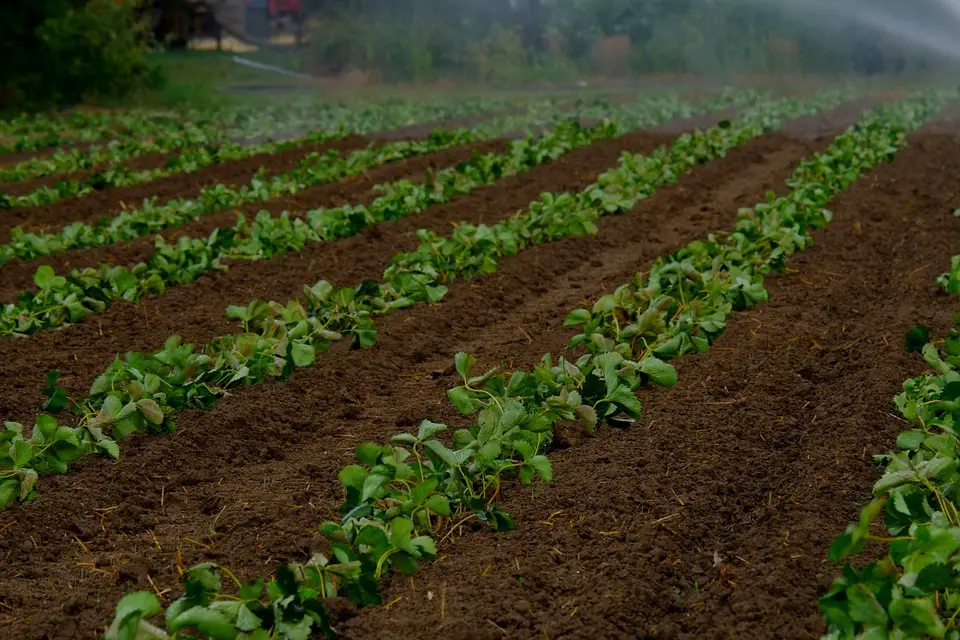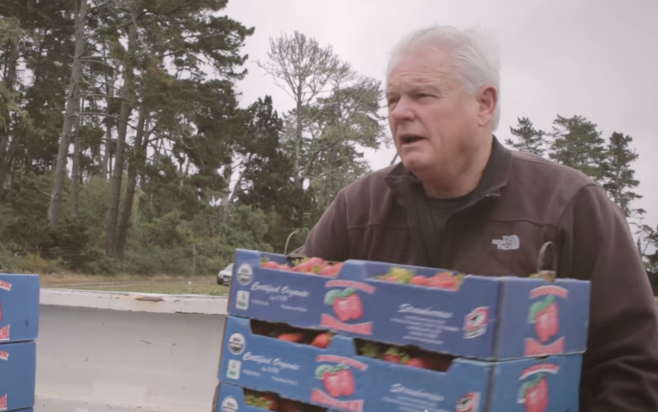
Jim Cochran on his organic strawberry farm in Santa Cruz, CA. He was poisoned by his own pesticides before deciding to switch away from “conventional” strawberries.

Cochran switched to organic strawberries against all odds…And couldn’t be happier.
While it’s been proven time and time again that “conventional” agriculture, the byproduct of the post-World War II era and the chemicals that remained, causes serious harm, most people don’t realize just how bad it’s gotten.
Jim Cochran, a strawberry farmer outside of Santa Cruz, California, found out first-hand. While growing conventional strawberries on his farm in 1981, he was poisoned by harmful pesticides (just as 10-20,000 American farm workers are each year), and it ended up changing his entire outlook on life and farming.
“My eyes started to water, and I started to get all jittery,” he says. “I said ‘Oh boy, this is not good stuff…We have to get away from this stuff.”
Disillusioned with pesticides after suffering from neurological issues for months, Jim went against the grain and decided to grow organic strawberries, something that most farmers did not believe was possible at the time.
Now, roughly 35 years after the pesticide incident, Jim has a thriving organic farm, the Swanton Berry Farm, which welcomes in visitors from across the farming community, eager to discover how the country’s first large-scale commercial organic strawberry grower made it work.
Instead of chemicals, Cochran has leaned on beneficial bugs, a single row planting technique, crop rotations, and other old school techniques that have become a lost art in today’s chemical-intensive farming world. Today, he shares his knowledge with other farmers (and he recently shared his story in the video below from Earth Justice).
Here are some core facts he wants you to know about conventional versus organic strawberry farming:

An Acre of Non-Organic Strawberries Uses 300 lbs of Pesticides (1,100% More Than Most Other Crops)
Even though one of the worst cancer-causing pesticides, methyl iodide, was removed by the Environmental Protection Agency (EPA) in 2012, other dangerous chemicals are being heavily used on strawberries today, reported Prevention.
Chemicals such as methyl bromide, chloropicrin, and Telone (1,3-D) are fumigants that are linked to cancer, developmental problems and hormone disruption, said Senior Scientist with Pesticide Action Network Margaret Reeves, PhD. Reeves wants stricter rules for berry growers to minimize toxic exposures.
“It should be clear that current laws and regulations aren’t doing enough; over 5.5 million pounds of chloropicrin are applied in California alone,” said Reeves.

Cochran stacks boxes of organic strawberries at Swanton Berry Farm.
Altogether, a Pesticide Action Network Analysis found 54 different pesticides on samples of strawberries.
The pesticides have a hazardous impact on human health (carcinogenic, hormone disruptors, neurotoxins, and reproductive toxins) and can have a devastating environmental impact on honeybees. And as Jim’s story shows, conventional strawberries and other chemical-intensive crops poses serious health risks.
Buyer Beware: Organic Strawberries are Not Always 100% Organic
While buying organic is a better choice, it’s important to know that you the organic strawberry industry still has a lot of work to do. Both state and federal regulations permit farmers to buy non-organic plants, which were fumigated, and still call the harvested strawberries organic.
Fumigants are a type of pesticide that have been linked to cancer and developmental problems.
Jim is teaming up with other farmers to find ways to grow the plants without fumigation. For now, your best bet is to know your farmer and ask the right questions before buying.
“I recognize that there are obstacles and difficulties, that’s the way change happens, it’s doable, yes,” he said.
*****
Support the organic food industry!
Find the best organic supplements, whey protein, organically sourced Vitamin C and more – Here
The Best Organic and Pasture-Raised Goods, On Sale Now!
Find It – Here
******
Beneficial Bugs, Single Row Planting, and Other Valuable Organic Farming Methods
While the debate often centers around pesticides and fertilizer, true organic farming is about much more than that.
There are many guides available to growing strawberries organically, such as this one compiled by the University of California. And Jim’s success story (see video below) shows that it can be done on a large scale.
Beneficial bugs used by Jim are natural enemies to strawberry pests, and include: parasitic wasps and flies, minute pirate bugs, bigeyes bug, lacewings, damsel bugs, ladybeetles, and syrphid flies.
Many beneficial bugs can be purchased on gardening sites or attracted by planting specific plants.
Crop rotation is a technique of planting different crops in the same ground on different years, and it helps control soil illnesses and pests, while also attracting beneficial bugs. One of the most heavily used crops in rotation with strawberries is broccoli (due to its anti-fungal properties).
And finally, single row planting makes plants give more yield as they do not have to compete for nutrients as they do in a tightly-planted field. Single row is also less likely to grow diseases.
Learn more about Jim’s story, including his unique way of treating farm workers, in the video below from Earth Justice:
Thanks for reading! If you’d like to check out my favorite organic and pasture-raised supplements (electrolytes and bone broth are among my favorites), check out the deals from Paleo Valley here!
Thanks for installing the Bottom of every post plugin by Corey Salzano. Contact me if you need custom WordPress plugins or website design.




